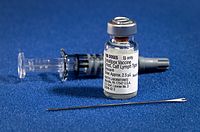
Photo from wikipedia
Correspondence to Prof Jeffrey V Lazarus; jeffrey. lazarus@ isglobal. org © Author(s) (or their employer(s)) 2022. Reuse permitted under CC BYNC. No commercial reuse. See rights and permissions. Published by… Click to show full abstract
Correspondence to Prof Jeffrey V Lazarus; jeffrey. lazarus@ isglobal. org © Author(s) (or their employer(s)) 2022. Reuse permitted under CC BYNC. No commercial reuse. See rights and permissions. Published by BMJ. INTRODUCTION Vaccination is the cornerstone of current strategies to mitigate the COVID19 pandemic, through reductions in transmission, morbidity and mortality. To optimise the impact of vaccination, an approach for equitable global distribution which minimises vaccine wastage is essential. Yet, after more than a year of distributing COVID19 vaccines, unnecessary vaccine wastage continues, with wastage rates as high as 30%. Globally, highly inequitable distribution of COVID19 vaccines persists, despite the approval and mass manufacturing of COVID19 vaccines in highincome countries (HIC), and agreements with initiatives such as COVAX—the vaccines pillar of the Access to COVID19 Tools Accelerator—to support vaccination in lowand middleincome countries (LMIC). To date, HIC have administered over 2.3 billion doses (79% of the population) and have procured over 7 billion doses, some of which may go to waste as vaccination rates are stagnating, while in lowincome countries only 15% of the population has been vaccinated. Of equal importance, effective supply chain management for the distribution of COVID19 vaccines in LMIC should be improved to overcome the ineffective practice of HIC donating ‘abouttoexpire’ vaccine doses to LMIC, which exacerbates the issue of overall wastage. Such ‘latedate donations’ create the false impression that HIC are ‘doing their bit’ while LMIC are incapable of effectively distributing vaccines.
Journal Title: BMJ Global Health
Year Published: 2022
Link to full text (if available)
Share on Social Media: Sign Up to like & get
recommendations!